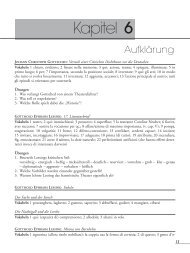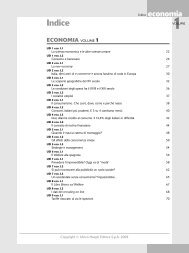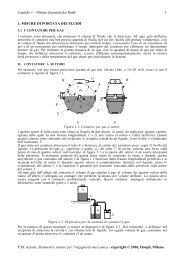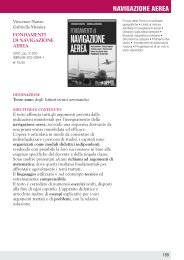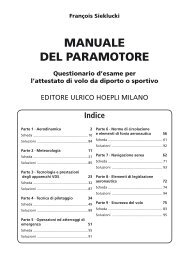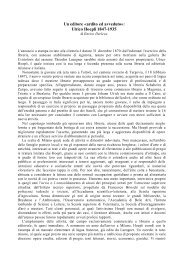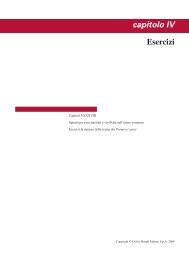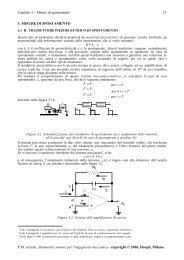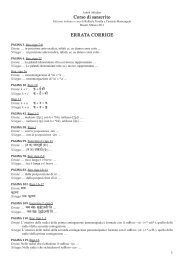10 La sicurezza alimentare e l'HACCP - HOEPLI.it
10 La sicurezza alimentare e l'HACCP - HOEPLI.it
10 La sicurezza alimentare e l'HACCP - HOEPLI.it
Create successful ePaper yourself
Turn your PDF publications into a flip-book with our unique Google optimized e-Paper software.
LA SICUREZZA ALIMENTARE E L’HACCP 121<br />
Tabella <strong>10</strong>.2 I sette principi del<strong>l'HACCP</strong> secondo il Codex Alimentarius( 1 ).<br />
Principle 1<br />
Conduct a hazard analysis by identifying and evaluating the potential<br />
hazard(s) associated w<strong>it</strong>h food production at all stages,<br />
from growth, processing, manufacture and distribution, until<br />
the point of consumption. Assess the likelihood of occurrence<br />
of the hazard(s) and identify the measures for their control<br />
Principle 2<br />
Determine the Cr<strong>it</strong>ical Control Points (CCPs).<br />
A “CCP” means a step at which control is essential to prevent<br />
or eliminate a food safety hazard or reduce <strong>it</strong> to an acceptable<br />
level.<br />
A “step” means a point, procedure, operation or stage in the food<br />
chain, including raw materials, from primary production to<br />
final consumption.<br />
Principle 3<br />
Establish cr<strong>it</strong>ical lim<strong>it</strong>(s) which must be met to ensure that the<br />
CCP is under control<br />
Principle 4<br />
Establish a system to mon<strong>it</strong>or control of the CCP by scheduled<br />
testing or observations<br />
Principle 5<br />
Establish the corrective action to be taken when mon<strong>it</strong>oring indicates<br />
that a particular CCP is not under control<br />
Principle 6<br />
Establish procedures for verification which include supplementary<br />
tests and procedures to confirm that the HACCP system is<br />
working effectively<br />
Principle 7<br />
Establish documentation concerning all procedures and records<br />
appropriate to these principles and their application<br />
HA. Identificare i rischi e valutarne<br />
la grav<strong>it</strong>à<br />
CCP. Definire i sistemi di prevenzione<br />
cr<strong>it</strong>ici<br />
Fissare i lim<strong>it</strong>i dei parametri<br />
cr<strong>it</strong>ici da tenere sotto controllo<br />
Attuare un sistema di registrazione<br />
dei dati cr<strong>it</strong>ici da tenere<br />
sotto controllo<br />
Definire le azioni correttive da<br />
intraprendere in caso di non<br />
conform<strong>it</strong>à di un parametro di<br />
controllo<br />
Verificare che gli obiettivi<br />
igienici del sistema sono consegu<strong>it</strong>i<br />
Documentare il sistema<br />
( 1 )“Guidelines for the Application of the Hazard Analysis Cr<strong>it</strong>ical Control Point (HACCP) system”,<br />
Codex Alimentarius, 1993.<br />
Il metodo riassunto nei 7 principi del Codex Alimentarius richiede ulteriori<br />
approfondimenti per poter condurre alla programmazione di un sistema di<br />
autocontrollo. Il testo di Peri et al. (1997b) ha riformulato i 7 principi facendogli<br />
corrispondere un decalogo di attiv<strong>it</strong>à. Ad esso si riferisce la norma UNI<br />
<strong>10</strong>854:1999. Il metodo che descriviamo di segu<strong>it</strong>o è ispirato alla logica del<br />
decalogo e riprende la sequenza della figura 13.2 di questo testo.<br />
1. Identificare i fattori di rischio pertinenti<br />
Nel sistema di autocontrollo il danno a cui ci riferiamo prior<strong>it</strong>ariamente riguarda<br />
la salute del consumatore, pertanto i fattori di rischio che vengono<br />
presi in considerazione sono quei contaminanti che possono determinare pa-



